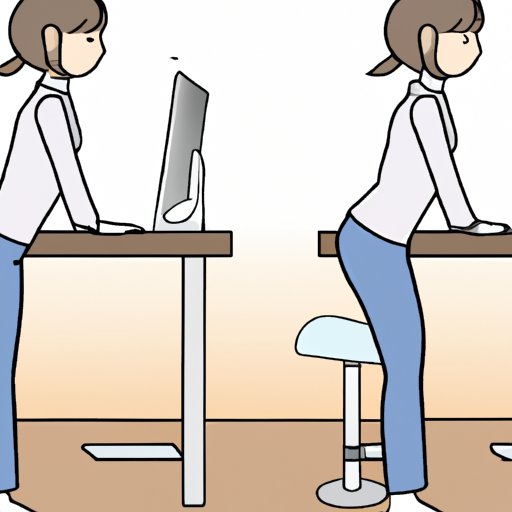Introduction
In recent years, standing desks have become increasingly popular among office workers. But are they really good for you? In this article, we’ll explore the potential health benefits of standing desks, compare the pros and cons of sitting versus standing, and provide a comprehensive guide to setting up an ergonomic standing desk.

Examining the Health Benefits of Standing Desks
Standing desks have been found to have numerous health benefits. Let’s take a closer look at some of these advantages:
Improved Posture and Reduced Back Pain
According to a study conducted by the University of Toronto, using a standing desk can improve your posture and reduce the risk of back pain. The study found that participants who used standing desks reported lower levels of discomfort than those who used traditional sitting desks.
Increased Energy Levels
Another benefit of standing desks is increased energy levels. According to research conducted by the University of California, San Diego, standing desks can boost energy levels throughout the day, which can lead to improved productivity and focus.
Decreased Risk of Cardiovascular Disease
Finally, standing desks can also decrease the risk of cardiovascular disease. According to a study published in the American Journal of Preventive Medicine, standing desks can reduce the risk of heart disease by up to 40%.
A Comparison of Sitting vs. Standing: What’s Best for You?
When it comes to choosing between sitting and standing, there are both advantages and disadvantages to each option. Let’s explore the pros and cons of each:
Advantages of Sitting
The main advantage of sitting is that it can be less tiring and more comfortable in some cases. Sitting also requires less energy and allows for a wider range of motion, making it easier to type or write.
Advantages of Standing
On the other hand, standing has several advantages. As mentioned previously, standing can improve posture, reduce back pain, and increase energy levels. It can also help burn more calories and improve circulation. In addition, standing can make it easier to stay focused on tasks and may even help with creativity.
Exploring Ergonomic Solutions for Office Workers
If you’re considering using a standing desk, it’s important to ensure that your workspace is ergonomically designed. Here are some tips for creating an ergonomic standing desk setup:
Adjustable Desks
Investing in an adjustable desk is one of the best ways to create a comfortable and ergonomic workspace. Adjustable desks allow you to adjust the height of your desk to suit your needs, allowing for maximum comfort and productivity.
Monitor Arms
Using a monitor arm can help reduce neck and shoulder strain. Monitor arms can be adjusted to suit your preferred viewing angle, allowing for better posture and fewer aches and pains.
Keyboard Trays
Using a keyboard tray can help keep your wrists in a neutral position, reducing the risk of carpal tunnel syndrome. Keyboard trays can also help improve typing accuracy and speed.

Standing Desks: Pros and Cons
Although there are many potential benefits of using a standing desk, it’s important to understand the potential drawbacks as well. Here are some of the pros and cons of standing desks:
Pros
The main advantages of standing desks include improved posture, reduced back pain, increased energy levels, and decreased risk of cardiovascular disease. In addition, standing can help improve concentration and productivity.
Cons
The main disadvantage of standing desks is that they can be tiring and uncomfortable for some people. Standing for long periods of time can also lead to fatigue and soreness in the feet, legs, and back. Additionally, standing desks can be expensive, and not all workplaces are able to accommodate them.

A Comprehensive Guide to Standing Desk Setups
Now that we’ve explored the pros and cons of standing desks, let’s take a look at how to set up an ergonomic standing desk. Here are some tips for creating a comfortable and productive workspace:
Setting Up Your Desk
When setting up your desk, it’s important to make sure that it’s at the correct height. To find the optimal height, stand up straight and rest your forearms on the desk. Your elbows should be at a 90-degree angle. If your desk is too high or too low, you can use an adjustable desk or a footrest to make it more comfortable.
Adding Accessories
Adding accessories such as monitor arms, keyboard trays, and footrests can help create a more comfortable and ergonomic workspace. These accessories can help reduce strain on your neck, shoulders, and wrists, and can help improve posture and productivity.
Minimizing Discomfort
Finally, it’s important to take regular breaks when using a standing desk. Taking short breaks every hour or so can help reduce fatigue and discomfort. Additionally, it’s important to wear comfortable shoes and to move around periodically to keep the blood flowing.
Conclusion
In conclusion, standing desks offer numerous health benefits, including improved posture, increased energy levels, and decreased risk of cardiovascular disease. However, it’s important to note that standing desks can be tiring and uncomfortable for some people. When setting up a standing desk, it’s important to make sure that it’s at the correct height and to add accessories such as monitor arms and keyboard trays to create an ergonomic workspace. By following these tips, you can enjoy the benefits of a standing desk without sacrificing comfort.
(Note: Is this article not meeting your expectations? Do you have knowledge or insights to share? Unlock new opportunities and expand your reach by joining our authors team. Click Registration to join us and share your expertise with our readers.)
